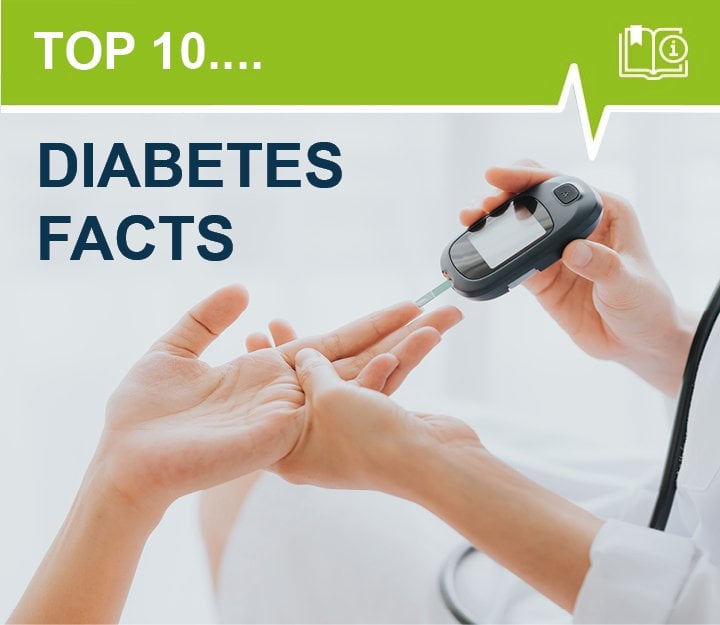Supporting Professionals Who Care
Top 10 Diabetes Facts


The history of diabetes
- The history of diabetes can be traced back to approximately 1550BC when it was mentioned in Egyptian manuscripts. However, it wasn’t until 250BC that Greek physician Apollonius of Memphis named the disorder after one of the main symptoms – patients passing more fluid than they can consume.
- Throughout history, doctors and physicians noted that people with diabetes had sweeter urine and in the late 18th century, Matthew Dobson identified that this sweeter urine was due to excess sugar in the patients’ urine and blood. Dobson also noted that some people would die straight away after the onset of symptoms, whilst others lived for much longer. This is one of the first mentions that there are two main types of diabetes.
- By the early 20th century, medical professionals took the first steps in treating diabetes and discovering its causes.
- In the 1920s, the first person treated with insulin was 14-year-old Leonard Thompson. He responded well and continued to live with treatment until he was 27 years old.
- Over the following decades, insulin treatments continued to increase the life expectancy of those with diabetes.
- In the 1940s, Dr Elliot Proctor Joslin developed the first hospital blood glucose monitoring system. During the 1950s and 1960s, oral drugs and urine strips were developed for home use.
- Nowadays thanks to research and innovative medical devices, those with diabetes can effectively manage their condition.

Top 10 diabetes facts
- Diabetes is a chronic disease that occurs either when the pancreas does not produce enough insulin or when the body cannot effectively use the insulin it produces. Insulin is a hormone that regulates blood sugar. Hyperglycaemia, or raised blood sugar, is a common effect of uncontrolled diabetes and over time leads to serious damage to many of the body's systems, especially the nerves and blood vessels.
- 422 million people worldwide and more than 4.9 million people in the UK have diabetes.
- There are 2 main types of diabetes. Type 1 diabetes is where the body's immune system attacks and destroys the cells that produce insulin. Type 2 diabetes is where the body does not produce enough insulin, or the body's cells do not react to insulin. During pregnancy, some women have such high levels of blood glucose that their body is unable to produce enough insulin to absorb it all. This is known as gestational diabetes.
- Type 1 diabetes can develop quickly over weeks or even days. Many people have type 2 diabetes for years without realising because the early symptoms tend to be general.
- Type 2 diabetes is far more common than type 1. In the UK, around 90% of all adults with diabetes have type 2. This type of diabetes can be the result of excess body weight and physical inactivity.
- More people than ever are at risk of type 2 diabetes. If nothing changes, the charity Diabetes UK predicts that 5.5 million people will have developed diabetes in the UK by 2030.
- The main symptoms of diabetes before diagnosis are: feeling very thirsty, peeing more frequently than usual, particularly at night, feeling very tired, weight loss and loss of muscle bulk, itching around the penis or vagina, frequent episodes of thrush, cuts or wounds that heal slowly, and blurred vision.
- There are no lifestyle changes you can make to lower your risk of type 1 diabetes. The pancreas no longer produces insulin, so people with type 1 diabetes have to inject insulin to control their blood glucose levels.
- Most people need medicine to control their type 2 diabetes. Medicine helps keep your blood sugar level as normal as possible to prevent health problems. Diabetes usually gets worse over time, so medicine doses need to be monitored and adjusted. People with type 2 diabetes can help manage their condition through healthy eating, regular exercise and achieving a healthy body weight.
- Those more at risk of developing type 2 diabetes are: people aged over 40 (or 25 for south Asian people), people who have a close relative with diabetes (such as a parent, brother or sister), people who are overweight or obese and those of Asian, African-Caribbean or black African origin (even if they were born in the UK).

Day to day life


For those with diabetes, keeping an eye on their blood sugar levels, the types of food they eat and how active they are is vital in keeping on top of their condition.
A typical day will consist of monitoring:
Blood sugar levels
This could be once a day, or several times a day and will indicate how much medication or insulin will be needed that day. Machines like a continuous glucose monitor (CGM) help to monitor this.
Diet
Changing their diet to help manage their condition. Ensuring they stick to a healthy and balanced diet will not only help their blood sugar levels but also their energy levels throughout the day.
Medication plan
Depending on the type of diabetes they have will depend on the type of medication they need to take. This will either be daily pills, insulin injections or a combination of the two.
Exercise
Being fit and active will not only help keep a healthy weight, but will also improve energy levels.

FURTHER INFORMATION
Now that you have enhanced your knowledge of diabetes, be sure to browse through our complete range of Blood Glucose products. If you need help and advice you can get in touch with our expert team on 01329 311451 or email info@dsmedical.co.uk
All the information on this page has been sourced from the World Health Organisation, the NHS and Diabetes UK.


